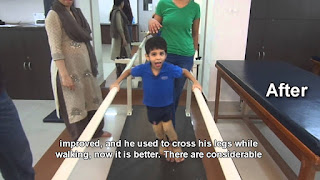Quadriplegia is a type of a cerebral palsy in which all the four limbs gets affected. Just like other types of cerebral palsy, Quadriplegia is recognized by stiff contracted muscles. However, the level of severity will defer from child to child. Those children suffering with moderate quadriplegia will be able to walk by themselves, sit and perform other similar tasks, while the children with more severe cases will face difficulties in various aspects of day to day life.
The major cause of Quadriplegia Cerebral Palsy is a spinal cord injury, but certain other conditions can also cause a similar paralysis like Cerebral palsy and strokes. The Amount of Impairment resulting from Spinal Cord Injury shows the Part affected and the Damage happened to the Spinal Cord.
Being the Central Parts of the Nervous System any injury to Brain and Spinal Cord can be damaging. Movement and Sensation gets weakened when the Spinal Cord is Injured as the Brain fail to properly Communicate with the Spinal Cord. The Spinal Cord is the Nervous System inclosed in the vertebrae and discs which make up the Spine.
Spastic Cerebral Palsy:
The pyramidal tract is responsible for voluntary movements that consists of two groups of nerve fibers. They fall from the cortex into the brain stem. They are responsible for communicating the brain’s movement to the nerves located in the spinal cord that will prompt the event. Pyramidal Spastic Cerebral Palsy would indicate that the tract is injured or not functioning properly. Pyramidal Cerebral Palsy indicates the injury is outside the path in areas like cerebellum, basal ganglia, and thalamus,. Pyramidal and is a key Factor to movement impairments. Spasticity implicit increased muscle tone. Muscles will continually contract, making the limbs stiff, resistant, and rigid to relaxing or flexing . Reflexes can be overstress, while movements tend to be awkward and jerky. Often, the legs and arms are affected. The pharynx, tongue, and mouth, can be affected, as well, impairing breathing, speech, eating, and swallowing.
Spastic Cerebral Palsy is mostly hypertonic and accounts about 70 to 80 percent of Cerebral Palsy cases. The injury to brain is referred to as upper motor neuron and where the damage occurs in the pyramidal tract.
The stress on the body that is created by spasticity can result in associated conditions like as limb deformities, hip dislocation, and scoliosis,. One major concern is the constantly contracting of muscles that leads to joint deformities.
Spastic Cerebral Palsy is often named with a topographical method that describes which parts are affected, such as spastic quadriplegia, spastic Diplegia, and spastic Hemiparesis.
Non-Spastic Cerebral Palsy:
A couple of styles of non-spastic Cerebral Palsy are every characterized by using particular impairments; one of the principal traits of non-spastic Cerebral Palsy is involuntary motion. Movement can be gradual or rapid, frequently repetitive, and on occasion rhythmic. Planned moves can exaggerate the effect – a situation referred to as arm tremors. Stress can worsen the involuntary actions, while regularly removes them.
An injury in the brain outside the pyramidal tract causes non-spastic Cerebral Palsy. Due to location of injury mental impairment, and seizures are likely less. Non-spastic CP lowers down the likelihood of limb and joint deformities. The ability to speak may be detached as a result of impairment.
Non-spastic Cerebral Palsy is divided into two very groups, dyskinetic and ataxic. Together they make 20 percent of Cerebral Palsy cases. Dyskinetic makes up 15 percent of all Cerebral Palsy cases, and ataxic comprises 5 percent only.

No comments:
Post a Comment